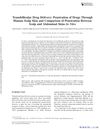The In Vitro Use of the Hair Follicle Closure Technique to Study the Follicular and Percutaneous Permeation of Topically Applied Drugs
March 2012
in “
ATLA. Alternatives to laboratory animals
”
hair follicle closure technique hair follicles transdermal penetration caffeine diclofenac flufenamic acid ibuprofen paracetamol salicylic acid testosterone porcine skin Franz-type diffusion cells interfollicular permeation follicular permeation percutaneous permeation hair follicle closure skin penetration Voltaren Advil Tylenol aspirin pig skin Franz cells skin absorption follicle absorption skin permeation
TLDR Hair follicles significantly affect the skin absorption of some drugs.
This study from 2012 investigated the use of a hair follicle closure technique in vitro to assess the role of hair follicles in the transdermal penetration of various topically applied drugs, including caffeine, diclofenac, flufenamic acid, ibuprofen, paracetamol, salicylic acid, and testosterone. Using porcine skin in Franz-type diffusion cells over 28 hours, the research differentiated between interfollicular and follicular permeation. Results showed that caffeine and flufenamic acid had significantly higher percutaneous permeation via hair follicles, while paracetamol and testosterone also indicated the importance of the follicular pathway. No significant difference was found for diclofenac, ibuprofen, and salicylic acid. The study concluded that the hair follicle closure technique is a viable in vitro method for studying drug permeation pathways, potentially reducing the need for in vivo testing.







